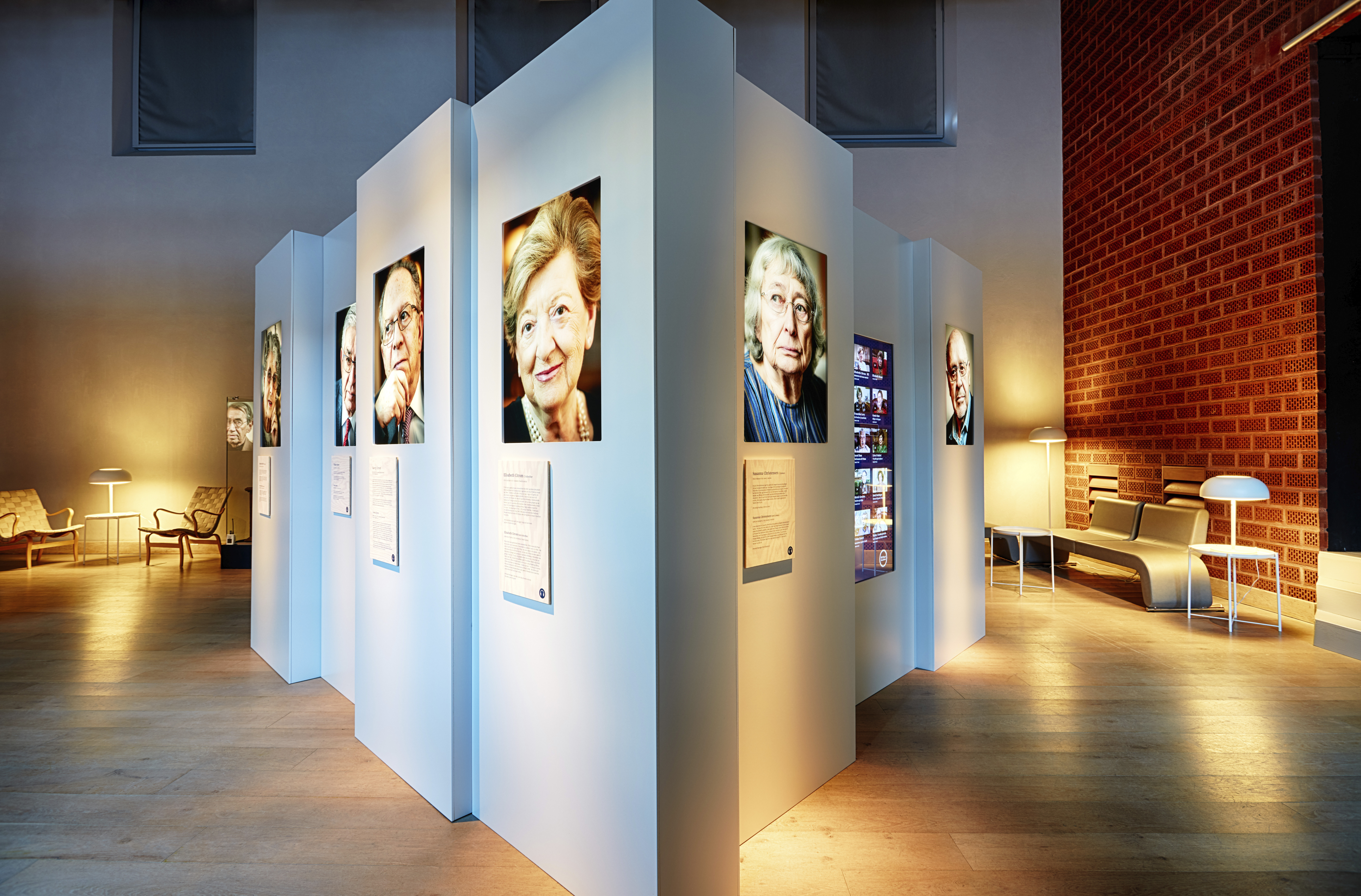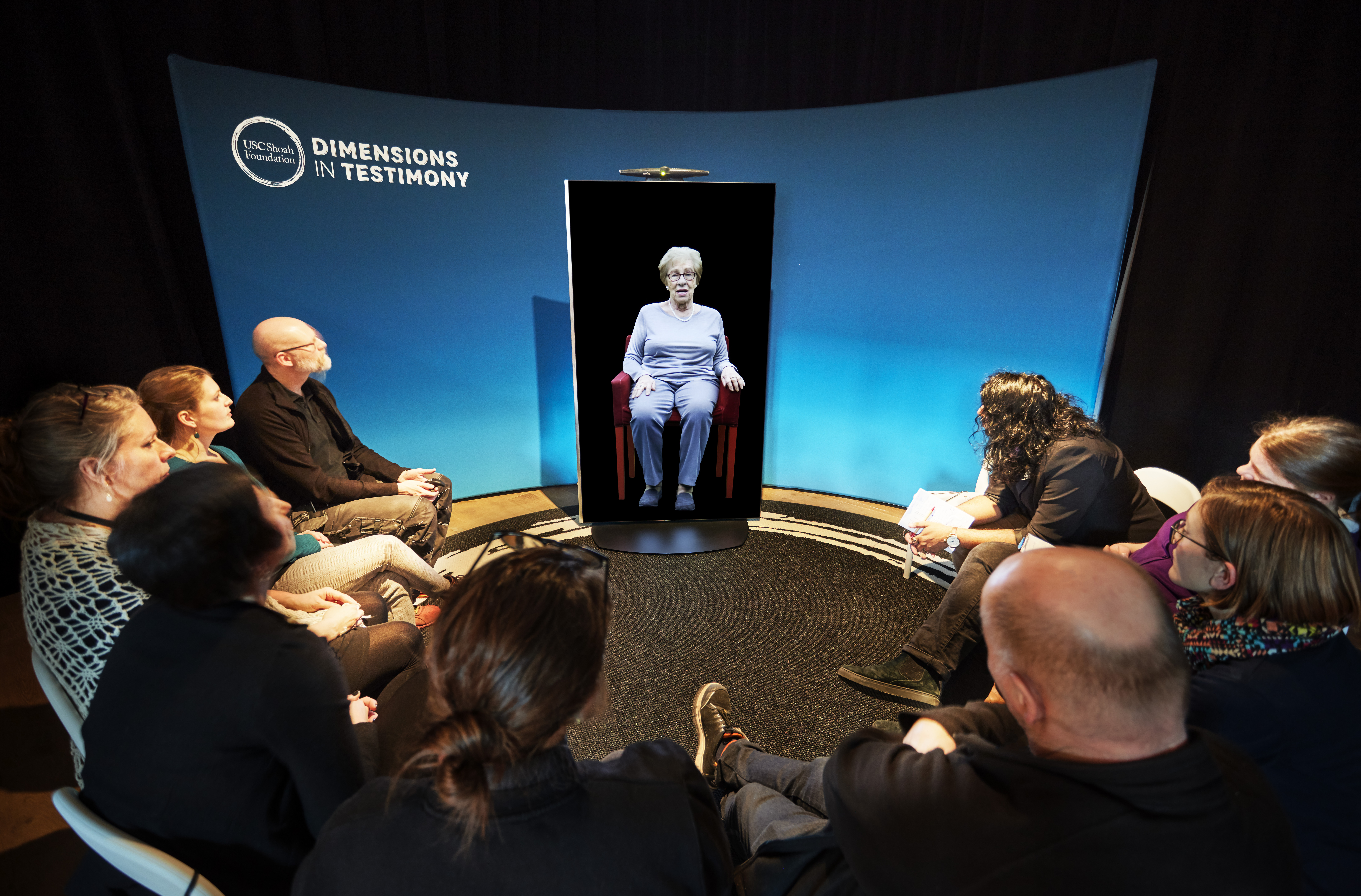Swedish History Museum becomes first European museum to exhibit Dimensions in Testimony

 Visitors interact with Dimensions in Testimony at the Swedish History Museum’s “Speaking Memories” exhibit. (Photo: Erik Lernestål/National Historical Museums)
Visitors interact with Dimensions in Testimony at the Swedish History Museum’s “Speaking Memories” exhibit. (Photo: Erik Lernestål/National Historical Museums)In addition to the interactive-biography exhibit created with USC Shoah Foundation by renowned Broadway designer David Korins, the space features close-up portraits of survivors along with clips of their video testimonies.
The museum today also began offering access to the 55,000 testimonies of witnesses to genocide in USC Shoah Foundation’s Visual History Archive. Other parts of the exhibit are dedicated to life in Sweden directly after the Holocaust, presenting personal stories and artifacts found in the camp Lovö, where survivors were placed upon their arrival to Sweden after World War II.
The opening ceremony included a keynote by USC Shoah Foundation Finci-Viterbi Executive Director Stephen Smith, as well as a recorded message by the Institute’s founder, Steven Spielberg.
 The Swedish History Museum’s “Speaking Memories” exhibit. (Photo: Erik Lernestål/National Historical Museums)
The Swedish History Museum’s “Speaking Memories” exhibit. (Photo: Erik Lernestål/National Historical Museums)In his remarks, Smith acknowledged the courage it takes to give testimony. He cited the example of Sidney Shachnow, a Holocaust survivor who later became a major general in the U.S. military and earned two Silver Stars for valor. Smith recounted Shachnow’s reluctance to give his testimony in a conversation they had.
“It does not take much courage to command 14,000 armed killers,” Shachnow told Smith. “But I can tell you I do not have the courage, even now, to sit in front of your camera and tell my story. I can’t face that pain.”
Shachnow eventually had a change of heart and gave his testimony six months later, in 2013. He died in October at age 83.
Smith noted that the Nazis strove to eliminate Jews from history. But by telling their stories, survivors were able to ensure that the cruelty of the Holocaust would never be forgotten.
“We’re here to celebrate the fact that you Holocaust survivors had the courage to tell your stories,” he said. “It sounds quite easy – speaking memories – but actually, this is an act of resistance. I often think of the Shoah Foundation archive as being the ultimate act of resistance.”
In his remarks, Spielberg talked about the importance of paying attention to what the survivors have to say about their experiences.
“Their perspective should always be heard and heeded in this world where hate still thrives,” Spielberg said. “We support them and lift their voices because some of the very things that led to the Holocaust are surfacing again. Hatred and violence, racism, antisemitism, xenophobia – these are the rising trends of the 21st century and every effort to counteract hate can be the difference between life and death. Every partner in this endeavor is a lifesaver.”
Also speaking was Piotr Cywinski, the director of the Auschwitz-Birkenau Memorial and Museum. He urged listeners to let the lessons of the Holocaust guide their lives. Artifacts from his museum were lent to the Swedish exhibit.
“What would you like to be in your life?” he asked. “A life of a bystander or a life of the righteous?”
Speaking in both English and Swedish, Lizzie Oved Scheja, the director of Jewish Culture in Sweden, said that interacting with a living survivor is an experience that can’t be matched, but in years to come, future generations will still be able to listen to their voices.
“What do we do when the survivors are no longer with us, when they don’t go to schools anymore, when they don’t write books anymore?” she asked. “Nothing can replace a meeting with a Holocaust survivor. Nothing can replace listening to them in school. Their eyes, their voices, their stories being told person to person. But we can do whatever we can do.”
“Speaking Memories” is made possible thanks to generous support from USC Shoah Foundation board members Ulrika and Joel Citron, Elisabeth Citrom, Ide and David Dangoor, and Annika and Gabriel Urwitz.
“Speaking Memories” is a collaboration between The Swedish History Museum and Jewish Culture in Sweden in cooperation with USC Shoah Foundation and Auschwitz-Birkenau Memorial and Museum.
Like this article? Get our e-newsletter.
Be the first to learn about new articles and personal stories like the one you've just read.